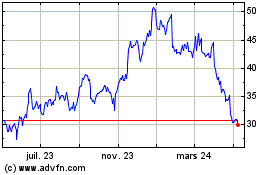Chip Stocks' Fate Hinges on Trade Deal -- WSJ
19 Mars 2019 - 8:02AM
Dow Jones News
By Jessica Menton
This article is being republished as part of our daily
reproduction of WSJ.com articles that also appeared in the U.S.
print edition of The Wall Street Journal (March 19, 2019).
Shares of chip makers are surging toward their best quarter in
more than two years as U.S.-China trade tensions have thawed, but
they face a critical test as a trade deal is hammered out.
The PHLX Semiconductor Index, which includes chip makers such as
Intel Corp., Nvidia Corp. and Advanced Micro Devices Inc., has
advanced 20% in 2019, topping the S&P 500's 13% rise this year
and heading toward its best three-month period since the third
quarter of 2016. The index is 4% away from its record, set in March
2018.
Shares of semiconductor companies, which have been caught in the
crosshairs of the trade battle, have bounced back as tensions have
eased. But stumbling blocks remain, including concerns over China's
policies on intellectual property, technology, cybersecurity,
currency, agriculture and energy.
If a trade agreement doesn't come to fruition or terms of the
deal disappoint, analysts caution it could upend the rally in chip
shares.
"The space that has benefited the most from the China black
cloud being removed from tech is semiconductors," said Daniel Ives,
a Wedbush Securities analyst. "But those stocks would be front and
center in terms of being punished if the ultimate trade deal isn't
what investors were hoping."
Semiconductor shares are vulnerable to a trade war because China
is a strong driver for the chip-equipment sector, which includes
several hot areas of growth including gaming and artificial
intelligence.
The tariff battle threatens to raise costs for companies, which
investors fear will dent profit growth. The S&P 500
semiconductor group is expected to report a 24% drop in
first-quarter profits from a year earlier, compared with a 3.7%
decline expected for the S&P 500, according to FactSet.
The U.S. already imposed tariffs on $250 billion of imports from
China last year, as well as levies on steel and aluminum. President
Trump delayed an increase in tariffs on Chinese goods that had been
set to take effect earlier this month, as both sides discuss a date
for a potential summit.
"With tariffs going up, it's going to create slower export
opportunities for companies," said David Spika, president of
GuideStone Capital Management.
Pressure on chip stocks could be a bad sign for the broader
market; the S&P 500 and its semiconductor group, which makes up
3.7% of the total index, have moved in the same direction 79% of
the trading days this year, according to Dow Jones Market Data.
Investors fear the tariff spat and a stronger dollar could hurt
demand for U.S.-made products. The Federal Reserve, which has held
off on lifting short-term interest rates, is monitoring business
spending closely as demand has waned for U.S.-made computers and
electronic products. Global personal-computer shipments slumped in
the fourth quarter, sliding 6.9% from a year earlier, according to
research firm Gartner. World-wide sales of smartphones also
stalled, climbing 0.1% from a year ago, separate data from Gartner
showed.
Wall Street is seeking more concrete details on the trade
negotiations. Two key issues investors want resolved: Chinese
intellectual-property theft and cyberspying. U.S. technology
companies are seeking new guardrails to crack down on the theft of
emerging wireless technology known as 5G and cloud computing.
Investors are also looking for the two countries to soften their
stance on merger-and-acquisition activity after the U.S. blocked
Singapore-based Broadcom Ltd.'s planned $117 billion takeover of
chip maker Qualcomm Inc. last year on national-security
concerns.
Michael Arone, chief investment strategist at State Street
Global Advisors, cautioned that the U.S. still faces trade
skirmishes beyond China, including the U.S. Mexico Canada Agreement
to replace Nafta and a post-Brexit U.K.
"There might be progress with China, but there are still trade
challenges on multiple fronts with Europe, Canada and Mexico," Mr.
Arone said. "When it comes to the U.S.-China trade deal, the devil
will be in the details."
Write to Jessica Menton at Jessica.Menton@wsj.com
(END) Dow Jones Newswires
March 19, 2019 02:47 ET (06:47 GMT)
Copyright (c) 2019 Dow Jones & Company, Inc.
Intel (NASDAQ:INTC)
Graphique Historique de l'Action
De Mar 2024 à Avr 2024

Intel (NASDAQ:INTC)
Graphique Historique de l'Action
De Avr 2023 à Avr 2024
